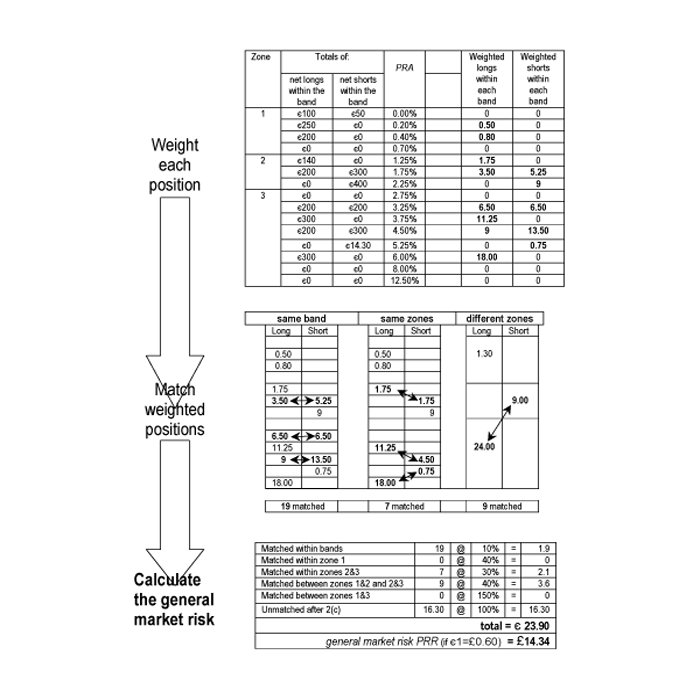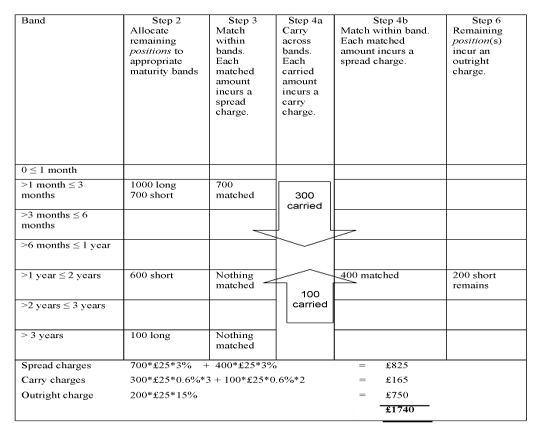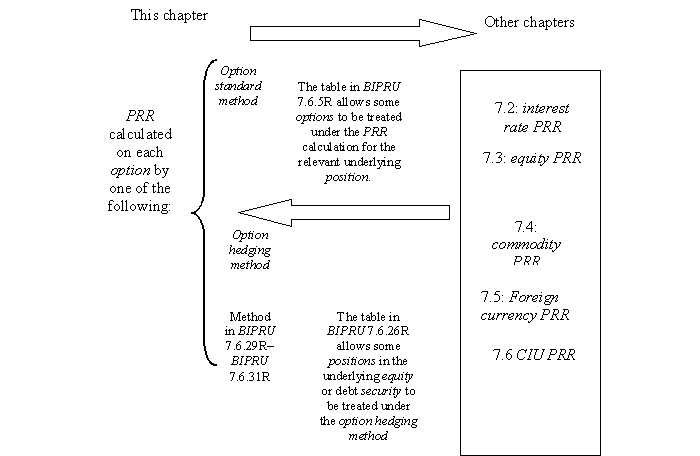BIPRU 7.1 Application, purpose, general provisions and non-standard transactions
Application
1This chapter applies to a BIPRU firm.
Purpose
General provisions: Obligation to calculate PRR
A firm must calculate a PRR in respect of:
-
(1)
all its trading bookpositions;
-
(2)
all positions falling within BIPRU 7.5.3 R (Scope of the foreign exchange PRR calculation), whether or not in the trading book; and
-
(3)
all positions in commodities (including physical commodities) whether or not in the trading book;
even if no treatment is provided for that position in the other sections of this chapter.
A firm must calculate a PRR for any position falling into BIPRU 7.1.3 R using:
General provisions: Non-trading book items
Positions in instruments which are non-trading book items should be treated under BIPRU 3 (Standardised credit risk), BIPRU 4 (The IRB approach) or BIPRU 13 (Financial derivatives, SFTs and long settlement transactions) unless deducted as an illiquid asset. If they fall into BIPRU 7.1.3R(2) or (3) they also give rise to a PRR charge.
General provisions: Frequency of calculation
A firm must be able to monitor its total PRR on an intra-day basis, and, before executing any trade, must be able to re-calculate PRR to the level of detail necessary to establish whether or not the firm'scapital resources exceed its capital resources requirement.
A firm may rely on intra-day limits for the purposes of BIPRU 7.1.6R.
Purpose of rules for non-standard transactions and instruments for which no PRR treatment has been specified
The methodologies which have been developed for calculating PRR charges have been based on existing instruments and assume instruments with standard characteristics. However, as a result of innovation and because there are instruments which, although based on a standard contract, contain structural features which would make the rules in the rest of this chapter inappropriate, flexible rules are required. The rules in this section about transactions for which no PRR treatment has been specified and non-standard transactions are designed to address this.
Instruments for which no PRR treatment has been specified
Where a firm has a position for which no PRR treatment has been specified, it must calculate the PRR for that position in accordance with BIPRU 7.1.12R-BIPRU 7.1.13R.
If BIPRU 7.1.9 R applies, a firm must document its policies and procedures for calculating the PRR for that position of that type in its trading book policy statement.
Under BIPRU 1.2.30 R (2) a firm should notify the appropriate regulator as soon as is reasonably practicable if its trading book policy statement is subject to significant changes. Therefore if a firm makes a change in accordance with BIPRU 7.1.10R it should consider whether it is necessary to report it to the appropriate regulator.
A firm may calculate the PRR for a position falling into BIPRU 7.1.9R by applying by analogy the rules relating to the calculation of the interest rate PRR, the equity PRR, the commodity PRR, the foreign currency PRR2, the option PRR or the collective investment undertaking PRR if doing so is appropriate and if the position and PRR item are sufficiently similar to those that are covered by those rules.
Where a firm has a position for which no PRR treatment has been specified and it is not applying BIPRU 7.1.12R, it must calculate a PRR of an appropriate percentage of the current value of the position calculated under GENPRU 1.3 (Valuation).
Instruments in non-standard form
-
(1)
- (a)
in a PRR item in non-standard form; or
- (b)
that is part of a non-standard arrangement; or
- (c)
that, taken together with other positions (whether or not they are subject to PRRcharges under BIPRU 7), gives rise to a non-standard market risk;
the firm must notify the appropriate regulator of that fact and of details about the position, PRR item, arrangements and type of risk concerned.
- (a)
-
(2)
Except as (1) provides to the contrary, (1) applies to a position that is subject to a PRR under BIPRU 7.1.3R.
-
(3)
The question of what is non-standard for the purposes of (1) must be judged by reference to the standards:
If a firm has a position or combination of positions falling into BIPRU 7.1.14R and the PRR relating to that position or positions materially underestimates the market risk incurred by the firm to which they give rise, the firm must calculate the PRR for that position or positions under BIPRU 7.1.13R.
Meaning of appropriate percentage for non-standard transactions
-
(1)
In BIPRU 7.1.13R and, to the extent that that rule applies BIPRU 7.1.13R, BIPRU 7.1.15R, an "appropriate percentage" is:
- (a)
100%; or
- (b)
a percentage which takes account of the characteristics of the position concerned and of discussions with the appropriate regulator or a predecessor regulator under the Banking Act 1987 or the Financial Services Act 1986.
- (a)
-
(2)
Compliance with (1) may be relied on as tending to establish compliance with BIPRU 7.1.13R or, insofar as it incorporates the requirements relating to an appropriate percentage, BIPRU 7.1.15R.
-
(3)
Contravention of (1) may be relied on as tending to establish contravention with BIPRU 7.1.13 R or, insofar as it incorporates the requirements relating to an appropriate percentage, BIPRU 7.1.15 R.
Stress testing and scenario analyses of trading book positions
3In carrying out the stress tests and scenario analyses required by BIPRU 7.1.17 R, a firm must incorporate and take into account any other relevant stress tests and scenario analyses that it is required to carry out under any other provision of the Handbook, and in particular under BIPRU 7.10.72 R where the firm has a VaR model permission.
3This paragraph gives guidance in relation to the stress testing programme that a firm must carry out in relation to its trading bookpositions.
-
(1)
The frequency of the stress testing of trading bookpositions should be determined by the nature of the positions.
-
(2)
The stress testing should include shocks which reflect the nature of the portfolio and the time it could take to hedge out or manage risks under severe market conditions.
-
(3)
The firm should have procedures in place to assess and respond to the results of the stress testing programme. In particular, stress testing should be used to evaluate the firm's capacity to absorb losses or to identify steps to be taken by the firm to reduce risk.
-
(4)
As part of its stress testing programme, the firm should consider how prudent valuation principles (see GENPRU 1.3) will be met in a stressed scenario.
3The stress testing and scenario analysis under BIPRU 7.1.17 R should be taken into account under the overall Pillar 2 rule.










